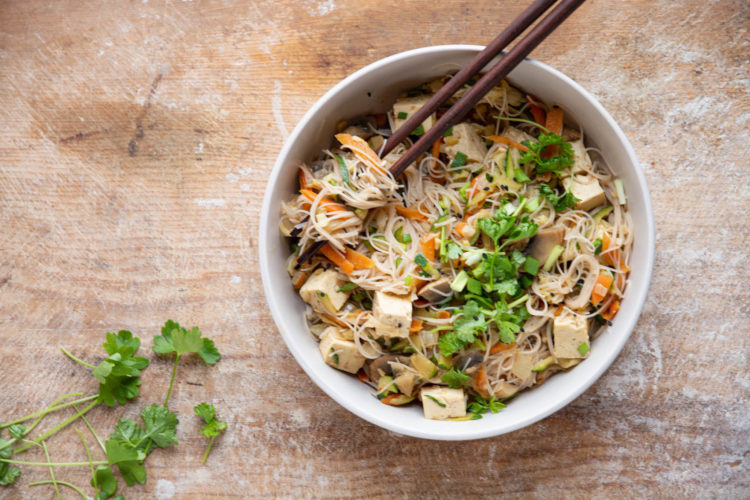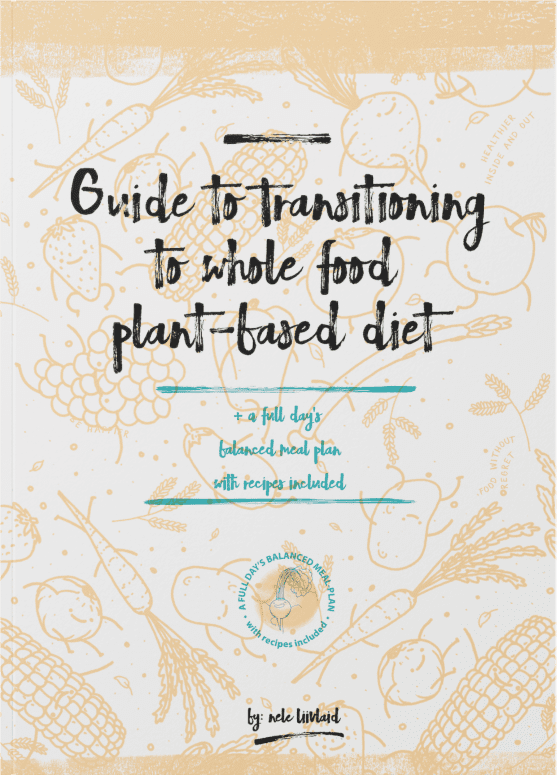Try this healthy version of vegan pad thai that uses no oil or dairy products. It’s a perfect weekday meal that’ll fill you up.
What I love about this recipe:
- relatively easy to make
- doesn’t require special ingredients like tamarind
- tastes so damn good!
Anyone interested in dietary tags, here we go: plant-based and vegan, oil-free, gluten-free, and relatively low-fat (26% of calories from fat).
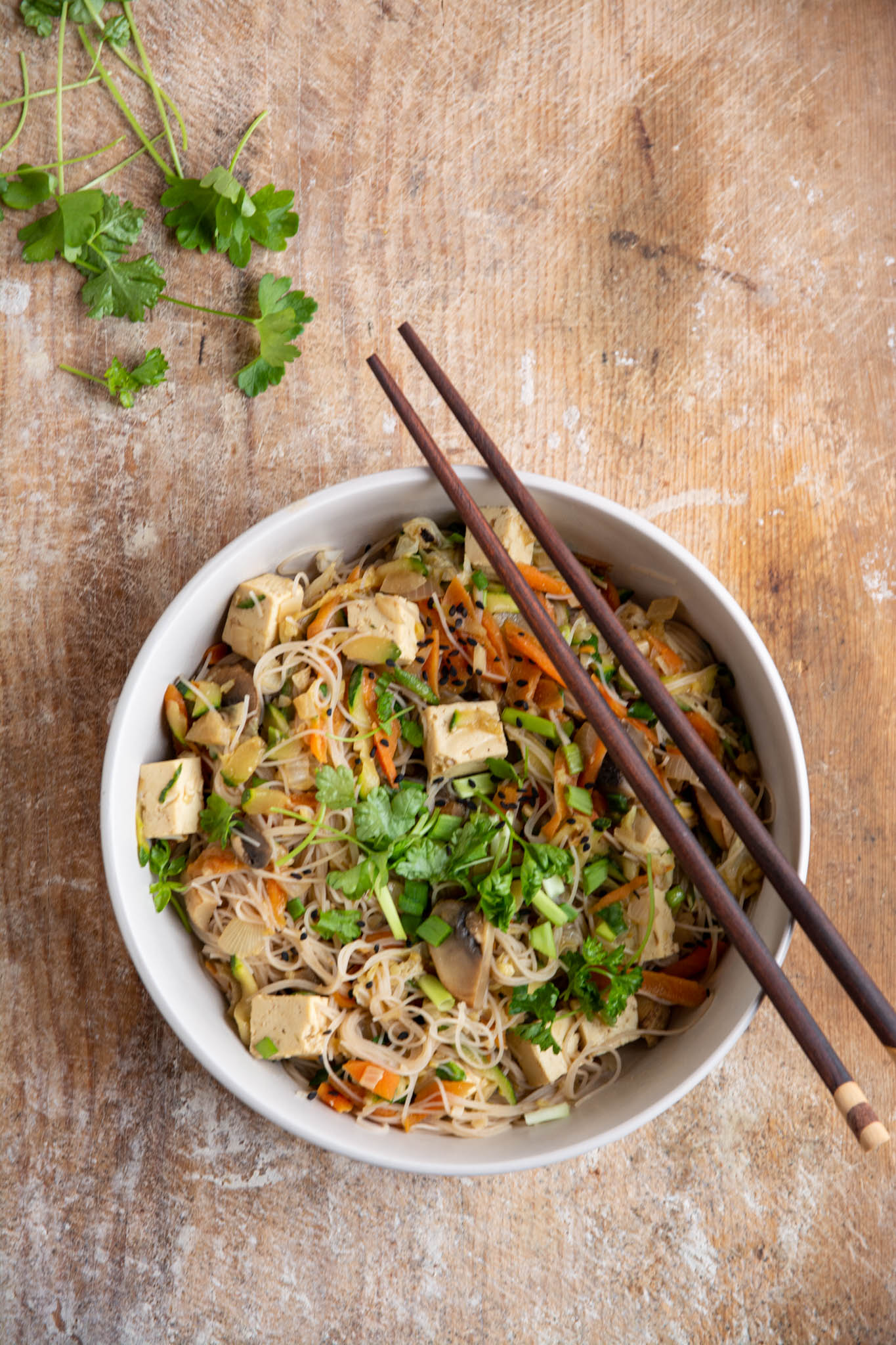
What is Pad Thai?
Traditional pad thai, phat thai, or phad thai is a stir-fried rice noodle dish commonly served as a street food in Thailand as part of the country’s cuisine.
Pad thai sauce is a combination on sweet, sour, and umami. Usually, coconut sugar, tamarind, and fish sauce give the desired result. Many recipes use plenty of oil in the sauce as well for stir-frying the vegetables. In fact, every time I have ordered pad thai in a restaurant, it’s been an utter disappointment because of the amount and quality of oil used. So, I needed to create my own vegan pad thai version!
Typically, pad thai recipes include white rice noodles, eggs, shrimps, and all kinds of vegetables that you can stir-fry. For example, Chinese cabbage, carrots, scallions, onion, garlic, ginger, broccoli, red cabbage etc.
How to Make Vegan Pad Thai
What’s the difference between traditional and vegan pad thai? Well, mainly it’s about loosing the eggs, shrimp, and fish sauce. In addition, we’re not going to use any oil and opt for brown rice noodles instead of white ones.
What’s more is that I wanted to try this recipe without tamarind which may be an ingredient difficult to get for many people.
The Ingredients
Let’s dive into the ingredients on my vegan pad thai recipe.
The main bulk ingredient is of course brown rice noodles. You may use white or brown, it’s totally up to you.
The sauce comes together with peanut butter, tamari, coconut sugar, balsamic vinegar, and water. In case you’re worried about the sodium content of tamari, opt for dark miso paste.
In case you’re wondering, balsamic vinegar takes the place of tamarind in this vegan pad thai recipe. By the way, if you happen to have tamarind, feel free to use the same amount instead of balsamic vinegar.
Feel free to use a whole food ingredient like date paste instead of coconut sugar. In fact, this would have been my first choice but I didn’t have any at home.
Let’s move on to the vegetables in this recipe. Mushrooms, onion, garlic, ginger, carrots, Chinese cabbage (pe-tsai), and zucchini come to offer their flavours.
As for the protein part, we throw in some garlic infused tofu cubes. By all means, use regular extra firm tofu or any kind of marinated tofu instead. I just love the garlic tofu I can get from my local store.
And finally, let’s add some chopped peanuts, scallions and parsley or coriander to garnish.
The Directions
There’s quite a bit of chopping to do but once that’s done, this vegan pad thai comes together very easily!
Start by preparing all the veggies. First, chop onion, garlic, and ginger. You can put those in the same bowl as they go in together.
Then, slice Chinese cabbage and mushrooms. Keep them separately as mushrooms go in sooner than the cabbage. And finally, coarsely grate carrot and zucchini.
Next, in a small bowl, mix the vegan pad thai sauce ingredients i.e., peanut butter, tamari, coconut sugar, balsamic vinegar, and water. Let me remind you once again that you can choose a whole food sweetener like date paste and use that instead of coconut sugar.
Now, before you start to work with your veggies, place the rice noodles in a big bowl and fill you kettle with water. However, don’t boil it yet!
Heat a large pot or saucepan and throw in slices mushrooms. Fry them dry until the water starts separating. You need to stir them occasionally.
Now, add onion, garlic, and ginger and a splash of water. Mix everything through and let them sauté with lid on for a couple of minutes.
Then, add the rest of the veggies with tofu cubes and stir well. Let them sauté or stir-fry them for about 3-4 minutes.
When the veggies are cooking, boil a kettleful of water and pour it over brown rice noodles. Let sit for 2-3 minutes (see the package for exact instructions).
Finally, drain the noodles and add them to sautéed veggies along with the pad thai sauce and stir. Serve immediately.
Optionally, add some chopped scallions, coriander or parsley, and chopped peanuts or almonds.
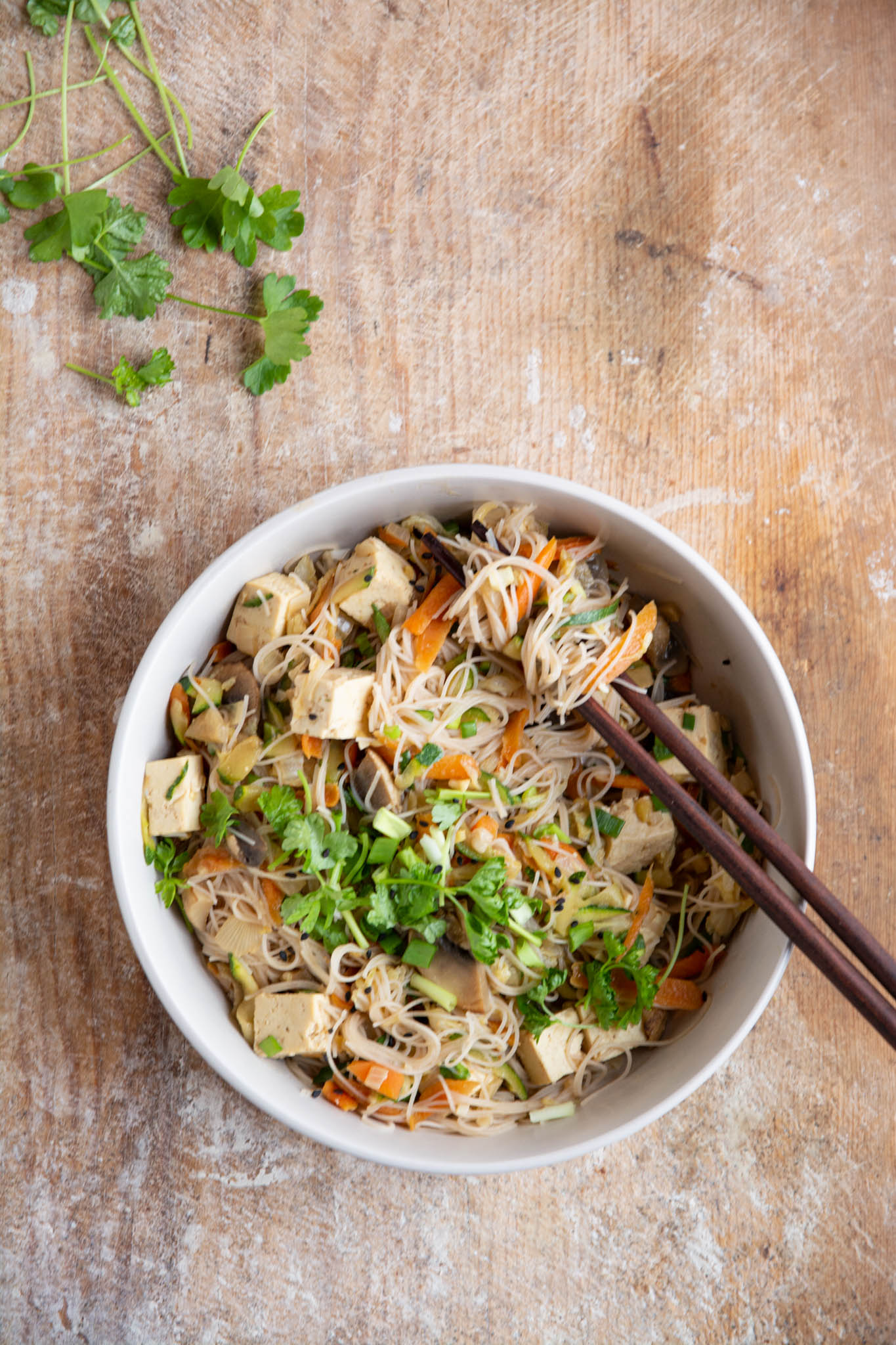
How to Store This Vegan Pad Thai
Having said that you should serve this pad thai immediately doesn’t mean that you can’t have leftovers. In fact, you can easily store anything that’s left over in a sealed container in the fridge and simply heat it up in the microwave oven the next day. I’ve done that and give my approval as it tastes as good as fresh!
Tips for Serving
Given that there’s an awful lot of noodles in this dish, I’d recommend you serve this vegan pad thai with some extra leafy greens or lettuce for more balanced meal.
Enjoy the tutorial video:
For more pasta recipes I recommend:
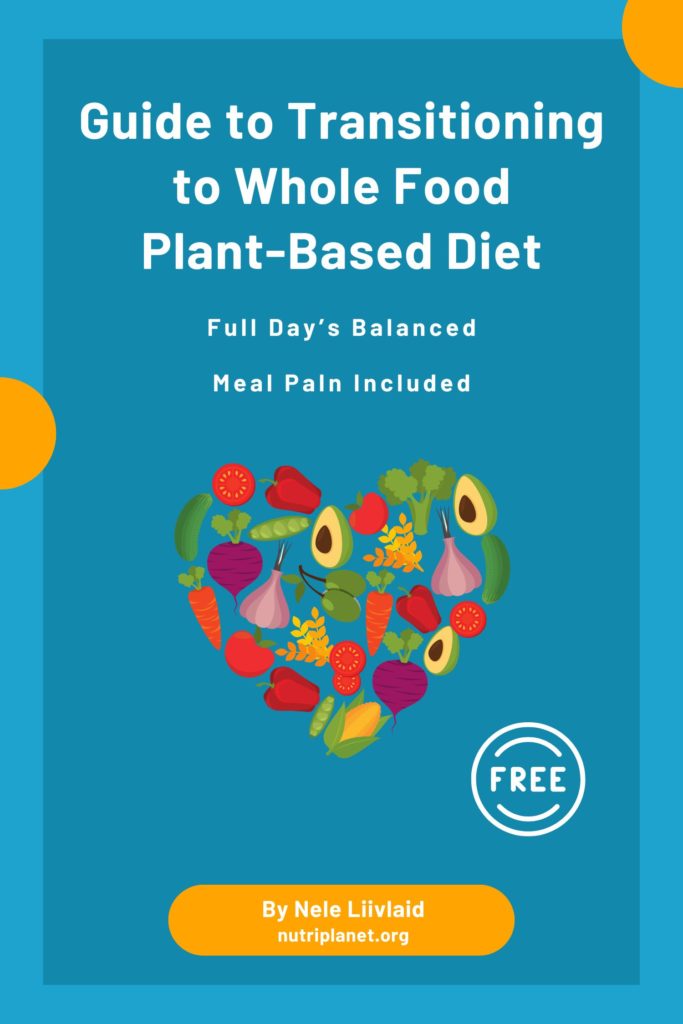
Download my FREE Guide to Plant-Based Diet
Including a full day’s meal plan!
Learn the basics, prepare your kitchen and pantry, compile a balanced meal plan, handle challenges with family and friends, learn the tricks of dining out as well as travelling.
Learn the secrets of weight loss, better health and happiness!
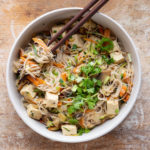
Vegan Pad Thai [Oil-Free]
- Total Time: 25 minutes
- Yield: 2 generous servings 1x
- Diet: Vegan
Description
Try this healthy version of vegan pad thai that uses no oil or dairy products. It’s a perfect weekday meal that’ll fill you up.
Ingredients
The Sauce
- 25g (0.9oz; 1 tbsp + 2 tsps) peanut butter
- 1 tbsp. balsamic vinegar
- 2 tbsps. tamari
- 1 tbsp. coconut sugar or date paste or date syrup or date sugar
- 50g (1.8oz) water
The Noodles:
- 100g (3.5oz) brown rice noodles
The Veggies:
- 1 small onion, chop
- 3 garlic cloves, chop
- 3g piece of fresh ginger, chop
- 230g (8.1oz) button mushrooms, slice
- 75g (2.6oz; 1 cup shredded) Chinese cabbage (pe-tsai)
- 1 medium carrot, grate coarsely
- 170g (6oz) summer squash, grate coarsely
Instructions
- Start by preparing all the veggies. First, chop onion, garlic, and ginger. You can put those in the same bowl as they go in together.
- Then, slice Chinese cabbage and mushrooms. Keep them separately as mushrooms go in sooner than the cabbage.
- And finally, coarsely grate carrot and zucchini.
- Next, in a small bowl, mix the vegan pad thai sauce ingredients i.e., peanut butter, tamari, coconut sugar, balsamic vinegar, and water. Let me remind you once again that you can choose a whole food sweetener like date paste and use that instead of coconut sugar.
- Now, before you start to work with your veggies, place the rice noodles in a big bowl and fill you kettle with water. However, don’t boil it yet!
- Heat a large pot or saucepan and throw in slices mushrooms. Fry them dry until the water starts separating. You need to stir them occasionally.
- Now, add onion, garlic, and ginger and a splash of water. Mix everything through and let them sauté with lid on for a couple of minutes.
- Then, add the rest of the veggies with tofu cubes and stir well. Let them sauté or stir-fry them for about 3-4 minutes.
- When the veggies are cooking, boil a kettleful of water and pour it over brown rice noodles. Let sit for 2-3 minutes (see the package for exact instructions).
- Finally, drain the noodles and add them to sautéed veggies along with the pad thai sauce and stir. Serve immediately.
- Optionally, add some chopped scallions, coriander or parsley, and chopped peanuts or almonds.
Notes
Feel free to use tamarind paste instead of balsamic vinegar.
You may use dark miso paste instead of tamari (if you’re concerned about the sodium content). Apparently, the beneficial elements of fermented soybeans outweigh any negative effects from sodium.
- Prep Time: 15 minutes
- Cook Time: 10 minutes
- Method: Stovetop
- Cuisine: Thai
Nutrition
- Serving Size: 1/2 of the recipe
- Calories: 432 kcal
- Sugar: 16.3g
- Sodium: 594mg
- Fat: 12.4g
- Saturated Fat: 2.2g
- Carbohydrates: 65.8g
- Fiber: 6.6g
- Protein: 21.7g
Feel free to PIN the below image for future reference!
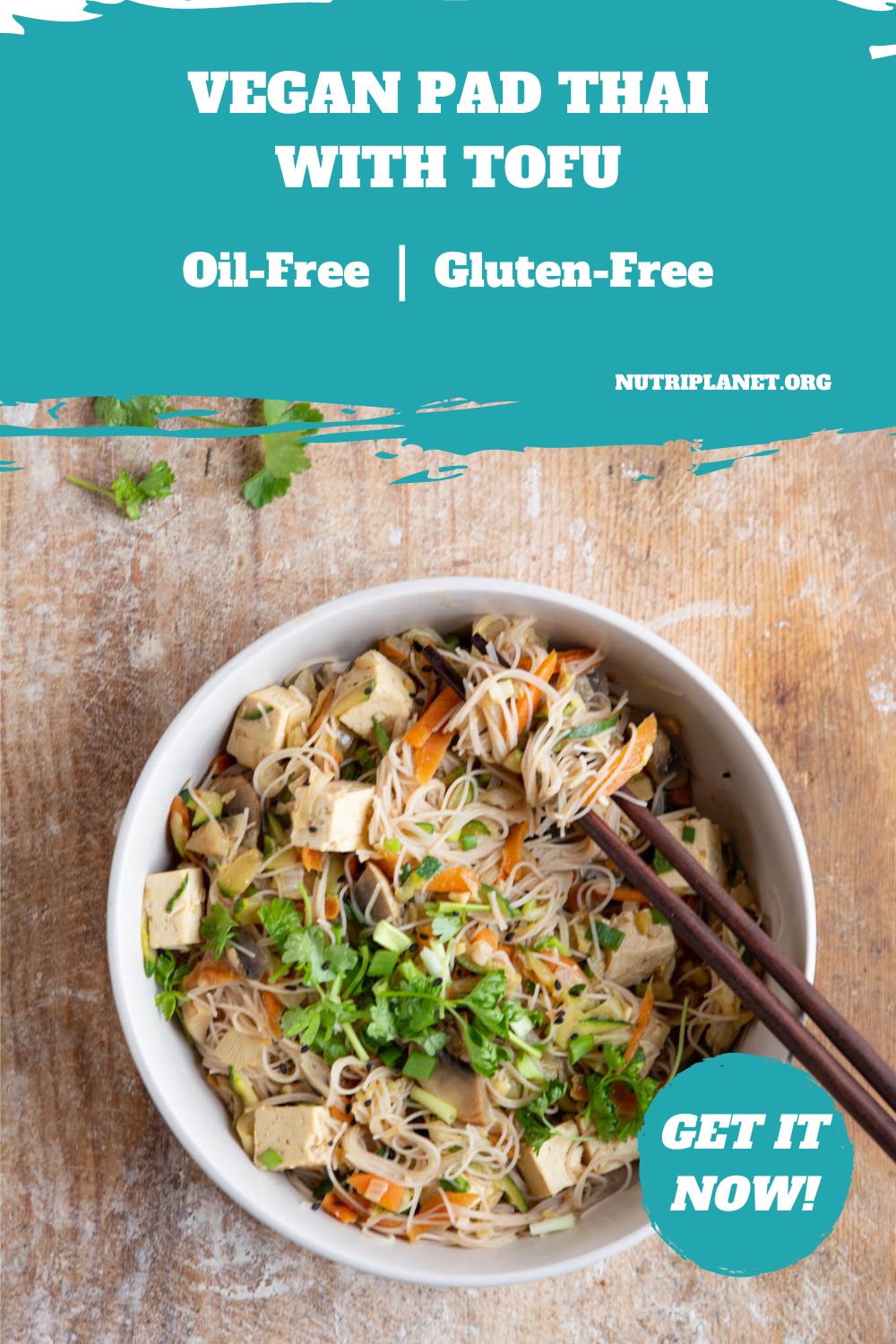
Disclosure: this post contains affiliate links. As an Amazon Associate I earn from qualifying purchases. For every purchase made from the links in this post, you’ll be able to support my work. So you can look after your health, and contribute to my mission at the same time. Thank you!

